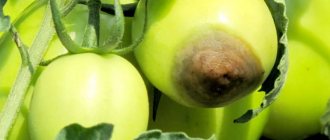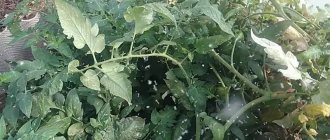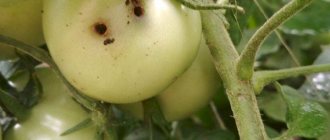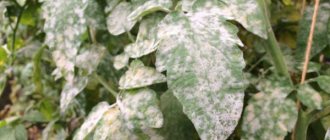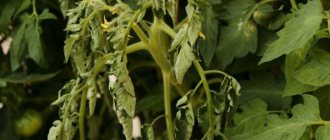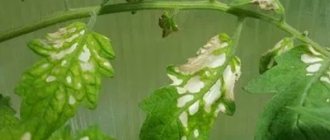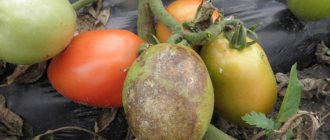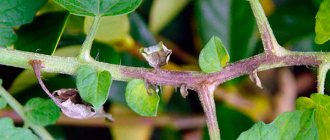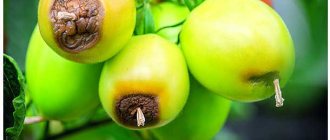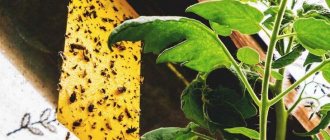Mold on tomatoes in a greenhouse is a disease caused by fungal spores. There are several types of fungal infections, but their mechanism of action is the same: these harmful microorganisms penetrate the plant, feed on its tissues and thereby inhibit the vital activity of the crop. Mold appears in a greenhouse much more often than in open beds, and affects seedlings en masse. If you do not start the fight in time, the disease can quickly spread to all the shoots and completely destroy the tomatoes in the greenhouse.
What it is?
Rot is considered a dangerous fungal disease that affects many vegetables, including tomatoes. There are the following types of rotting:
- Black rot is caused by the fungus Diplodina destructiva Petr.
- Gray mold is caused by Botrytis cinerea Pers.
- White rot is caused by Sclerotinia sclerotiorum.
As a rule, tomato rot develops in the absence of good soil disinfection and proper watering.
Pickling brown tomatoes
To prepare this savory and flavorful snack you will need:
- Tomatoes.
- Garlic – 8 cloves.
- Hot pepper – 1 pc.
- 1 bunch of celery.
- Black peppercorns – 10 pcs.
- Salt – 60 g.
- Bay leaf – 4 leaves.
- Water – 1.5 l.
Rinse the tomatoes thoroughly. Rinse the celery and chop. Peel the garlic, pass through a press and mix with celery.
Remove the stem and seeds from the pepper, cut it into as many pieces as there are fruits.
Make a deep longitudinal cut on each tomato. Put a piece of pepper and a little filling into it. Place vegetables tightly in a container.
Boil water, add dry ingredients - salt, sugar and throw in bay leaves. After the filling has cooled completely, pour it over the vegetables with the filling. Cover the workpiece with a lid and place under pressure. After three days, tasty, slightly spicy brown tomatoes can be served.
Read more recipes for lightly salted tomatoes here.
Reasons for appearance
There are many reasons for the appearance of rot on fruits. The most common are the main ones:
- Using untested seeds.
- Excess nitrogen, potassium, salt or magnesium in the soil.
- High air humidity.
- Damage to the root system.
- Lack of soil disinfection.
- Lack of sunlight.
- Lack of vitamins, especially calcium.
- Excessive soil irrigation.
Important: lack of moisture in the soil during the wilting period contributes to the formation of rot. Due to lack of moisture, the plant actively seeks it and takes it from the fruits. However, excess moisture can also cause rot.
Signs of defeat
Tomato rot is often confused with a disease called anthracnose. In this case, the leaves become covered with a layer of pinkish mold, which does not happen with any type of rot. The only symptom common to them is black-brown spots on the fruits. However, it is not difficult to distinguish these two diseases.
Symptoms of gray mold can be confused with late blight. With this disease, round watery spots appear on the fruits, and gray mold develops on the leaves and stems. The spots on the fruit enlarge and a brown liquid is released. In the case of gray mold, plants become covered with a fluffy coating, which is a characteristic sign of the disease.
Salted tomatoes with mustard without vinegar
For a three-liter glass container you will need:
- Ripe tomatoes.
- Salt – 4 level tablespoons.
- Bay leaf – 6 leaves.
- Black and allspice peas – 8 pieces of each component.
- Fresh dill - 2-3 stalks.
- Mustard powder - 1 heaped tablespoon.
- Garlic – 5 cloves.
- Chopped horseradish root - 1 teaspoon.
Rinse the jar thoroughly and pour boiling water over it. Place spices, washed and chopped herbs, peeled garlic and horseradish root at the bottom of the container. Rinse the vegetables, pierce the stems and place tightly in a jar.
Dissolve salt in a liter of water at room temperature and pour brine over the tomatoes. Place a clean piece of cotton cloth on top of the workpiece, and pour mustard on top of it. This will protect the salting from mold formation. There is no need to cover the product with a lid.
Cold-cooked salted tomatoes will be ready in about 10-15 days at room temperature.
Types, their descriptions and photos
Among the diseases of tomatoes, there are several types of tomato rot. These include gray rot, white rot and black rot. Each type of rot is caused by different pathogens and manifests itself differently.
Gray
This disease affects fruits grown both outdoors and in greenhouses. Gray mold is caused by high humidity and too much nitrogen fertilizer.
White
Compost and soil are considered the main source of the disease, so infected plants should be destroyed and not composted. White rot is caused by poorly disinfected soil. High humidity and low air temperature (below 18ºC) during planting also contribute to the development of white rot.
Black
The pathogen enters overripe fruits through cracks. Excess moisture in the air causes disease.
How do diseases develop and why are they dangerous?
- The fruits are covered with a white coating.
- Leaf spotting.
- Black rot. Black, spotted spots appear on the fruit, usually near the stalk or in damaged areas. The diseased tissue softens, the spots increase, and the plant dies.
- The leaves of the plant become watery and discolored.
- Fruit rot with a gray tint.
- White rot. This type of rot usually occurs on damaged parts of the fruit and usually appears during storage of the crop. External signs of the disease:
- Plant stem infection.
- A characteristic pubescent flower is formed.
- Gray rot. The disease spreads from plant to plant. Infected tomatoes quickly wither and die. The disease manifests itself as follows:
What should I do to get rid of it?
So what is the most effective way to combat tomato rot? There are basic rules that, if followed, will help you save your harvest. In addition, it is best to choose varieties that are most resistant to these diseases, and do not forget about crop rotation.
How to fight with agrotechnical methods?
Proper growing techniques are a great way to prevent tomatoes from rotting. Just follow the rules below to keep your plants healthy and strong:
- It is recommended to plant mustard, marigolds or calla lilies on the affected area. These plants secrete special substances that prevent the development of rot.
- In dry and sunny weather, it is recommended to cut out the affected parts of the plant with a knife.
- When watering the plant, avoid getting water on the leaves.
- Ventilate the greenhouse often.
- Maintain proper watering schedule. Water regularly, but do not overwater.
- Remove diseased fruit regularly.
- Mulch the soil. This will help distribute moisture evenly and keep the soil loose.
How to treat with folk remedies?
To combat rot, gardeners often use folk remedies. Here is one of the most effective:
- For the same purpose, plants can be sprayed with calcium. Spraying of tomatoes is carried out before they begin to flower, several times in the first week after transplanting into the soil. To prepare the solution you will need 40 g of calcium per 10 liters of water.
- The soil can be sprayed with a solution containing calcium. To prepare this fertilizer, dissolve 2 tablespoons of chalk in 10 liters of water. Fertilize moderately with this mixture. This way you will help the soil restore its calcium levels.
How to treat with chemicals and fungicides?
Disinfection of diseased plants with disinfectants plays an important role in the fight against rot of tomatoes:
- The vitriol solution is carefully poured into the lime solution. The resulting mixture must be thoroughly mixed.
- Pour 2 liters of hot water into any 10 liter non-metallic container and add 100g of copper sulphate (180p per 1kg). Mix thoroughly and add another 3 liters of cold water.
- Pour 4 liters of cold water into another container and then add the lime solution. Mix everything thoroughly and strain through a non-metallic sieve or cheesecloth.
- Prepare lime mortar. Mix 140-150g lime (170p per 20kg) in 1 liter of water.
- Cover the plant with a fungicide. The timing and frequency of application of fungicides for tomatoes are indicated in the instructions for the specific product. Here is one recipe for spraying: mix 300-330 g of CMC glue and 20-50 g of fungicide in 10 liters of water. Using chalk, make the mixture into a paste-like consistency. Cover the rotted areas so as to cover about 3 cm of healthy tissue. We recommend using fungicides such as Topaz (4880 rubles per 1 liter), Oksikhom (60 rubles per 10 g), Kuproskat (4830 rubles per 10 liters).
- Treatment with Bordeaux mixture. Infected tomatoes are treated three times with a break of up to 10 days. Gardeners recommend carrying out no more than 4 such treatments per season. If the disease has spread to seedlings, treat them with Bordeaux mixture 10-14 days before planting in a greenhouse or soil. The mixture is prepared according to the instructions:
We invite you to watch a video about gray mold prevention:
Biological drugs for treatment
Biological preparations are quite effective in combating gray mold. Natural remedies such as:
- Fitosporin-M.
- Gamair.
- Alirin-B.
- Agate 25K.
Biological preparations are considered safe for humans and non-toxic for bees.
Recipes for cooking tomatoes in a barrel
Preparing barrel tomatoes for the winter requires the use of the following ingredients:
- 25 g each dill and parsley
- 15 g horseradish leaves
- a few mint leaves
- several pieces of capsicum
- 15 g garlic
- leaves of grapes, currants, cherries - 4 pcs.
Preparing barrel tomatoes for the winter
Tomatoes should be firm and without damage. Tomatoes must be thoroughly washed and the stem removed from each one. Next, put 30% of all the specified spices on the bottom of the barrel, after which we add tomatoes to half the container. At the same time, it is advisable to place them tightly, because the taste of the dish depends on the density of placement in the barrels. So, if the fruits are not packed tightly, after salting they will be over-salted. In the middle we again put 30% of the taken spices and lay the fruits, placing the remaining seasonings on top.
In parallel with this, we prepare a special saline solution. The calculation is as follows - for green tomatoes you need to take about 800 g of salt per bucket of water, for red tomatoes - about 1 kg of salt. After preparation, the solution must be filtered, then it is poured into a barrel and the container with tomatoes is placed in the cellar.
Preparation of saline solution
Some tips for pickling:
- If mold appears on the surface of the fruit, it must be removed periodically. To reduce the possibility of fungus to a minimum, after you have poured the salt brine, add 2-3 tablespoons of vegetable oil to the barrel.
- It is preferable to salt tomatoes in small containers up to 50 kg. The larger the barrel, the higher the likelihood that the fruit will crack during the salting process. It is also recommended to pickle tomatoes of varying degrees of maturity in different containers.
Prevention measures
There are certain rules, following which you can avoid the appearance of rot and ensure the ripening of healthy and beautiful tomatoes. Prevention of this disease is as follows:
- Do not use large doses of fertilizers.
- Avoid damaging the plant's root system.
- Spray tomatoes with anti-rot preparations. Experienced gardeners recommend using Topsin M, Bayleton, Euparen multi.
- Shape the plants.
- Maintain the salt balance in the soil. Saline soils cause insufficient water supply to plants, which leads to calcium deficiency. Do not overfeed plants with magnesium and potassium.
- Get rid of the stems in a timely manner.
- Maintain a comfortable temperature for the tomatoes. Ventilate the greenhouse in hot weather. Shade plants with fabric or tint glass.
- Plant the seedlings at a distance from each other.
- Spray the tomatoes with a solution containing calcium.
- Do not allow plants to dry out or overwater.
Disinfection of planting material
The first step in the fight against rot is seed treatment. Planting material should be disinfected with a solution of potassium permanganate or ferrous sulfate:
- Ferrous sulfate is dissolved in the ratio: 1 g of the drug per 1 liter of water. Soak the seeds in the solution for one day and then dry them.
- First, soak the seeds in a 3% solution of potassium permanganate for half an hour, then rinse with warm water and dry.
Salted green tomatoes with garlic and herbs
This spicy, incredibly tasty appetizer is quite easy and quick to prepare.
- Garlic.
- Parsley.
- Green tomatoes.
- Red bell pepper.
- Hot string pepper.
To prepare the marinade:
- Water – 2 l.
- Vinegar – 110 g.
- Salt – 110 g.
- Sugar – 60 g.
In this recipe, it is recommended to use slightly whitish ripe fruits. Prepare the tomatoes: rinse and cut into quarters.
Wash the lettuce pepper, remove the stems and seeds, and cut into thin strips. For 1 kg of tomatoes you need to use 0.5 kg of pepper.
Rinse the greens and chop. Peel the garlic and cut into pieces. Remove the stem from the hot pepper, gut the seeds and cut into half rings. You can put a lot of greens, just like garlic. The amount of hot pepper may vary depending on your spicy taste.
Mix all ingredients and place in a barrel or large plastic container.
Boil water, add salt, sugar, mix well until the dry ingredients dissolve. At the end, pour vinegar into the marinade. Pour boiling brine over the vegetables until it completely covers them. After the finished product has cooled, cover it with a lid and place it in the refrigerator for a day.
The next day, the slightly spicy green tomatoes are ready to eat. If desired, they can be seasoned with vegetable oil and served as a side dish for any meat dish.
Gray leaf spot
Gray leaf spot is also called macrosporiosis and has nothing in common with gray mold. Tomato leaf mold is caused by the fungus Stemphylium solani, while gray leaf mold is caused by the bacterium Botrytis cinerea Pers.
When macrosporosis occurs, gray spots form on the leaves, which then completely affect the leaves and the plant dies. Gray rot affects the stem: the stem becomes covered with gray, ashen-colored spots. At a later stage, vascular necrosis develops in the stem, and the leaves begin to turn yellow.
Why does mold appear on tomatoes in a greenhouse?
The reason is the atmosphere in the greenhouse - humid and warm. The enclosed space of mini-tropics is most favorable for mold to settle in the soil, on parts of greenhouse structures, from where it migrates to plants.
Tomatoes become moldy in greenhouses when:
- the seed material is infected with a fungus;
- microorganisms are found in the soil;
- infection occurs through unsterile garden tools during pruning, picking and other procedures;
- greenhouses are not ventilated;
- Plants are over-watered.
Mold on tomato leaves in a greenhouse occurs when indeterminate varieties (tomatoes with unlimited bush growth) are not tied up and the ripening bunches lie on the ground.
Advice from gardeners
Experienced gardeners recommend the following method of combating rot: adding ash from burnt oak bark when transplanting seedlings (a glass of ash per hole), and also spraying during the period of bud formation.
An infusion for foliar feeding is prepared from 200 grams of ash and 10 liters of water. Pour water over the ash, bring the solution to a boil, boil for 10 minutes, and then leave to infuse for 24 hours. Then drizzle it over the tomatoes.
Tomatoes are often susceptible to various types of rot. To prevent this, it is enough to follow the rules of agricultural technology, water regularly and well, care for the plants and pay attention to varieties that are least susceptible to rotting. All these simple measures will help you reap a bountiful harvest and keep your plants healthy.
